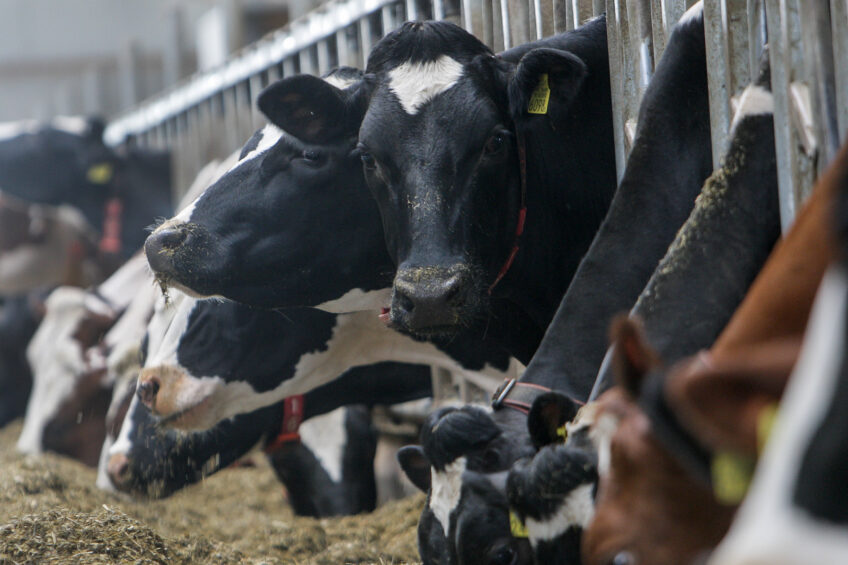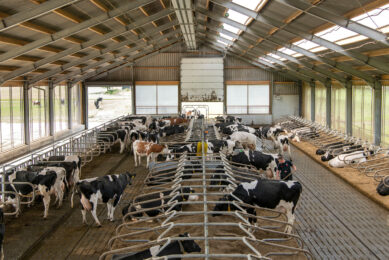Amino acid nutrition for lactating cattle

Not the crude protein but the amino acids are required nutrients for dairy cows. Balancing for amino acids is important as it is a contributing ?factor to higher milk yields, higher milk component levels and greater dairy herd profitability.
Balancing for amino acids (AA) is increasingly accepted in dairy nutrition. This is due to the desire to feed lower protein diets, high prices for protein supplements, an overall trend of higher milk protein prices, continued refinement and improvement of nutrition models, and increased availability of rumen-protected amino acids (RP-AA).
In 2001, the Dairy NRC model was released which allowed for evaluation of diets for rumen degradable protein (RDP), rumen undegradable protein (RUP) and for lysine (Lys) and methionine (Met) in metabolisable protein (MeP). Metabolisable protein is defined as the true protein that is digested post-ruminally and the component AA is absorbed by the intestine. For the dairy cow, AA and not protein are the required nutrients. Milk protein content and yield can be increased by improving the profile of AA in MeP, by reducing the amount of surplus protein in the diet, and by increasing the amount of fermentable carbohydrate in the diet. However successful balancing for AA requires acceptance of several basic aspects of AA nutrition and ‘letting go’ of balancing for crude protein (CP).
Sources of absorbed amino acids
In ruminants, AAs are provided by ruminally synthesised microbial protein (MP) and, to a lesser extent by endogenous protein. Microbial protein typically supplies a majority of the AA and may supply more than 50% of the absorbed AA in high-producing cows fed a high-concentrate diet that is balanced to meet requirements for rumen degradable protein (RDP) and RUP. The quantity of AA provided by endogenous protein secretions is smaller, assumed to account for less than 10% of total absorbed AA. Methionine and Lys have been identified as the two most limiting AA for lactating dairy cows fed maize-based rations. This is not surprising given the low concentrations of Met and Lys in most feed proteins relative to concentrations in rumen bacteria and in milk and tissue protein (Table 1).
Importance of histidine
Other essential AA have also been evaluated for their possible limitation after Lys and Met supplementation. Particular attention has been given to histidine (Hist) and the branched-chain AA (BCAA; isoleucine, leucine and valine in part because some models predict them as more limiting than other AA. However, results with Hist are much more positive than with BCAA. Hist maybe important when lower RUP diets are fed. Hist is the first limiting AA for milk and milk protein yields when high forage, grass silage diets, supplemented with barley and oats, with or without feather meal as primary source of supplemental RUP are fed. Further evidence for the significance of Hist as a limiting AA come from work by Lee et al., (2012) and Hadrova et al., (2012) where cows fed maize-containing diets, already supplied with supplemental Lys and Met, responded to Hist supplementation. In both sets of experiments there were low dietary concentrations of RUP (4.5 and 3.6% of diet DM, respectively). Dry matter intake and milk and milk component yields were restored back to positive control levels with supplemental Lys, Met and Hist.
Balancing dairy cow diets for amino acids
Considerable progress has been made in recent years to build nutritional models to predict supplies of absorbed AA for dairy cows. Further progress in balancing diets for AA could be made by establishing the optimal concentrations in MeP of the most limiting AA for the model of choice, formulating diets to come as close as possible to meeting those optimal concentrations, and reducing the RUP content of the diet as much as possible without sacrificing any production benefits realised by balancing for AA. The first step to balancing for Lys and Met (i.e., establishing the optimal concentrations in MeP) was accepted by NRC (2001). This approach not only eliminates the need for validated AA requirements, but it has the decided advantage of allowing for the establishment of optimal concentrations of the most limiting AA in MeP.
Enhanced milk and milk component yields
The benefits of balancing for AA, with the focus being almost entirely on Lys and Met thus far, are well known (Schwab, 2012). These include reducing the risk of an AA deficiency, optimising transition cow health, increasing milk and milk component yields, and feeding less RUP to post-transition cows. Feeding less RUP not only decreases feed costs but also allows for increased carbohydrate feeding. The consequence is increased synthesis of MP, a protein of high quality, and increased synthesis of volatile fatty acids, important substrates for lactose and fat synthesis. The benefits of balancing for AA are most noticeable in transition and early lactation cows but benefits exist throughout lactation. Enriching rations with metabolisable Lys and Met in seven trials commencing immediately post-calving or within the first 2 or 3 weeks of lactation and continuing to at least 120 days in lactation was summarised by Garthwaite et al., (1998). They showed that daily milk yield was increased by an average of 0.7 kg, milk protein by 80 g and milk protein increased by 0.16%. In five similar studies where the rations were enriched in Lys and Met in the close-up (pre-partum) ration as well as for the first third of lactation, daily milk yield was increased by an average of 2.3 kg, milk protein by 112 g and milk protein increased by 0.09%. In all cases, the AA-balanced diets had either the same or lower levels of dietary CP than the basal diets. This summary of experiments not only shows the importance of enriching diets with Lys and Met on milk performance, but it also shows that the principles of balancing rations for Met and Lys should be applied in the close-up rations to extract maximum benefit during lactation. Responses to enriched Met and Lys have sometimes been variable but in most cases, economic benefits were obtained. The poor responses almost always appeared to have been the result of less than optimum carbohydrate nutrition.
Improved efficiency of use of metabolisable protein
This factor is fundamental to achieving the benefit of balancing rations for Lys and Met. In essence, when an AA is limiting, the dairy cow has an oversupply of all other AA, and when it is supplied in more adequate amounts, the missing links are provided and more milk protein molecules can be synthesised. This reduces the surplus of the AA and unless there is a considerable surplus of MeP because of overfeeding RUP, the efficiency of utilisation of MeP is increased. It is essential to pay attention to the content of Lys and Met of MeP. As an example, consider the impact of a lower efficiency of utilization of MeP. For a cow producing 40 kg of milk at 3.0% milk protein, if the overall efficiency of MeP utilization falls from 0.67 to 0.60, milk protein yield would be predicted to drop by 10% (120 g). A 120 g loss in milk protein yield equates to 2 kg less milk with a lower milk protein concentration (-0.15%). This important facet of balancing rations for AA is illustrated by Piepenbrink et al., (1999). They fed a Met-enriched ration, and observed the response to increasing supplies of Lys. Milk protein secretion increased in a linear fashion. The optimum response to increasing daily MP-Lys up to an additional 34 g was an extra 173 g of milk protein (2.7 kg milk, +0.2% milk protein). The efficiency of utilization of MeP for milk protein synthesis was only 0.53 for the unbalanced ration without any supplemental Lys supplementation. Intakes of DM did not change. At the optimum level of Lys supplementation, the efficiency of utilisation of MeP was improved to 0.67. These results indicate that when only MeP is considered as the entity defining AA supplies, there is no estimation of likely limiting AA. Therefore, milk performance is likely to be less predictable because of this. Schwab et al., (2004) compared MeP, Lys, and Met supplies as predictors of milk volume and milk protein yield. Metabolisable protein supply does an adequate job (r2 of 0.65) of predicting milk volume and a slightly better job of predicting milk protein yield (r2 of 0.74). Compared to MeP, Met supply was a better predictor of both milk volume (r2 of 0.76) and milk protein yield (r2 of 0.81). However, when studies were limited to those in which the Lys:Met ratio in MeP was less than 3.25:1, Lys supply proved to be the best predictor of both milk volume and milk protein yield with r2 of over 0.90. This analysis shows that predictability of milk performance is improved by paying attention at least to the first two limiting AA. By continuing to formulate rations uniquely on a metabolizable protein basis with no consideration for metabolisable Lys and Met, performance will be depressed and less predictable, and milk protein and milk fat yields will not be optimised, reducing net returns from the sale of milk.
Effects on feed efficiency
The efficiency of MeP utilisation is improved when rations are balanced for Lys and Met and so is overall feed efficiency. Normally, this is expressed as kg of 3.5% fat-corrected milk per kg of feed DM consumed. Hutjens (2005) has proposed a measurement that can be calculated and used as an indicator of feed efficiency and another indicator that corrects for protein as well as fat which is more appropriate where the effects on milk protein yield are also important. High feed efficiency in itself may not be a good indicator of a healthy ration if it is at the expense of mobilising energy reserves too rapidly, which could lead to metabolic disorders and delayed or impaired reproduction. Nevertheless when rations are balanced for Lys and Met, due to the improved efficiency of use of MeP, less energy is needed to eliminate surplus amino acid-N as urea, allowing energy to be put to a more productive use. Also the improvement in feed efficiency and in particular energy status may be associated with other roles of Met in metabolism, rather than simply as a building block for milk protein synthesis.

Improved reproduction
Conventional wisdom would indicate that any ration manipulation that can help minimise metabolic disorders and improve energy status of cows in early lactation should also have the potential to positively influence reproductive parameters. Robert et al., (1997) observed that cows receiving a ration balanced for Lys and Met had higher progesterone levels pre successful ovulation than control animals. This is considered to potentiate a strong ovulation.
Also, during the 5 days after insemination progesterone, levels were higher, which is often regarded as a positive factor for the embryo to successfully implant. Thiaucourt (1996) demonstrated in field trials (53 farms, 2000 cows) that feeding rations formulated to be rich in Lys and Met improved timing to first insemination and calving interval by 5 days (P < 0.1). Balancing for AA should also positively influence reproductive function by facilitating a reduction in high circulating levels of blood urea through the lowering of ration CP content without hurting milk performance. There is a generally accepted negative association between plasma, serum, and milk urea N and conception rates in high producing lactating cows. Overfeeding RUP or RDP in the diet reduced uterine pH on day 7 of the oestrous cycle of heifers and in the case of overfeeding RDP this was associated with a much lower conception rate (Elrod and Butler, 1993).
A role in immune response?
The role of Met and Lys in immune function is still somewhat speculative in dairy cows. It has been shown in chicks that sulphur AA status is an important determinant of the immune response to a Sheep Red Blood Cell challenge. In newly arrived, “stressed” feedlot steers, Spears (1996) showed that fortifying the diets with Lys and Met reduced rectal temperatures compared to controls after inoculation with Infectious Bovine Rhinotracheitis intranasally followed 7 days later with an injection of pig red blood cells. This was accompanied by an improved humoral response as indicated by a higher IgM titre. In dairy cows, there is some indirect evidence that balancing rations for Lys and Met may positively impact the immune system. Thiaucourt (1996) reported the classical improvements in milk protein (+0.13%), and improved milk production in early lactation (+1.6 kg/day) when feeding rations balanced for Lys and Met. However, the somatic cell count was also reduced by 50,000/ml. There are several possible explanations for this phenomenon. The immune response is improved if animals have an improved energy status, the extra supply of Met increases circulating taurine levels thought to be important in maintaining the stability of cell membranes and in anti-oxidant reactions. The synthesis of the keratin ring, a protein rich in cysteine, at the extremity of the teat duct may be improved, enhancing the protection against intra-mammary infection.
Conclusions
There are several important points of protein and AA nutrition in dairy cows: Rumen-degradable protein (RDP) is required by rumen microorganisms and amino acids (AA) are required by the cow. It is also important to consider that amino acids are the required nutrients, not CP, for the dairy cow. In addition, methionine and Lys are the most limiting AA, and Met is almost always more limiting than Lys. Balancing for Lys and Met can provide significant opportunities for minimising the risk of cows experiencing AA deficiencies and for reducing the need for protein supplements. Increases in milk protein and fat concentrations observed with Lys and Met balancing reflect an improved protein status that can have far-reaching effects on health and performance. However, rumen-protected Met and Lys supplements should not be fed without confirmed estimates of metabolic bioavailability at commercial levels of supplementation. Finally, balancing for AA has, without question, been a contributing factor to higher milk yields, higher milk component levels, and greater dairy herd profitability for many dairy producers.
References are available on request.
Join 13,000+ subscribers
Subscribe to our newsletter to stay updated about all the need-to-know content in the dairy sector, two times a week.











